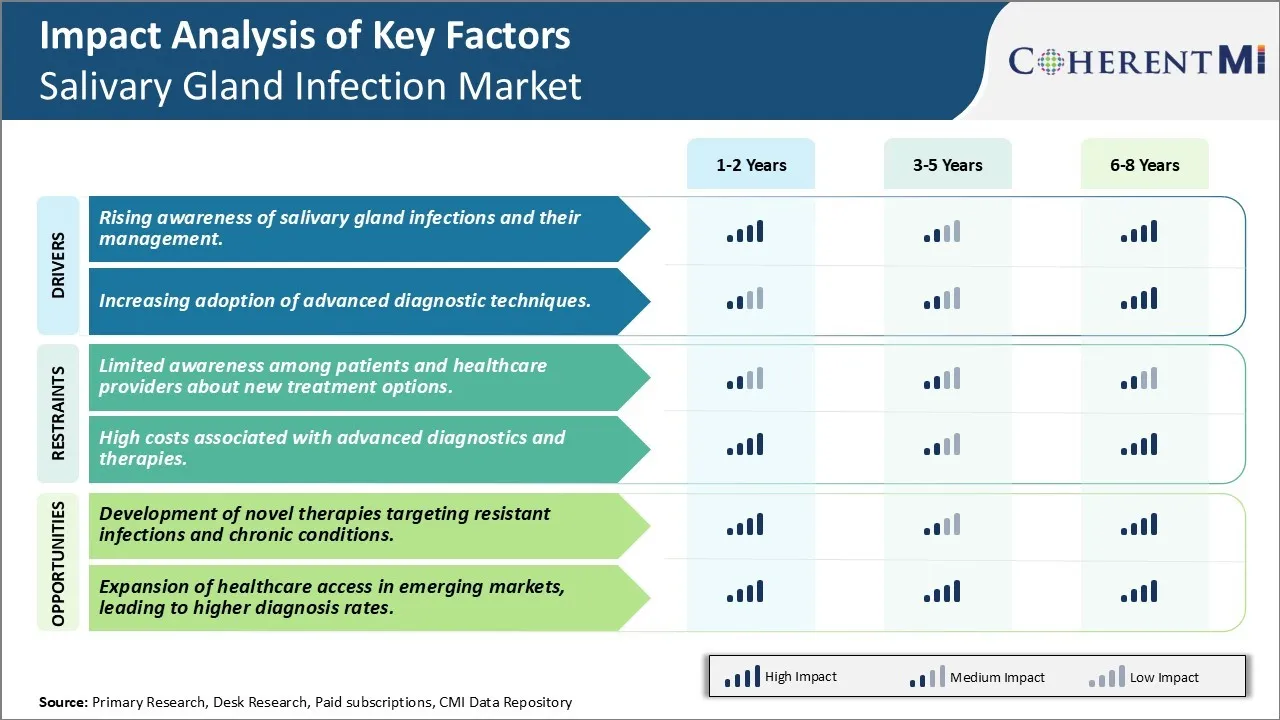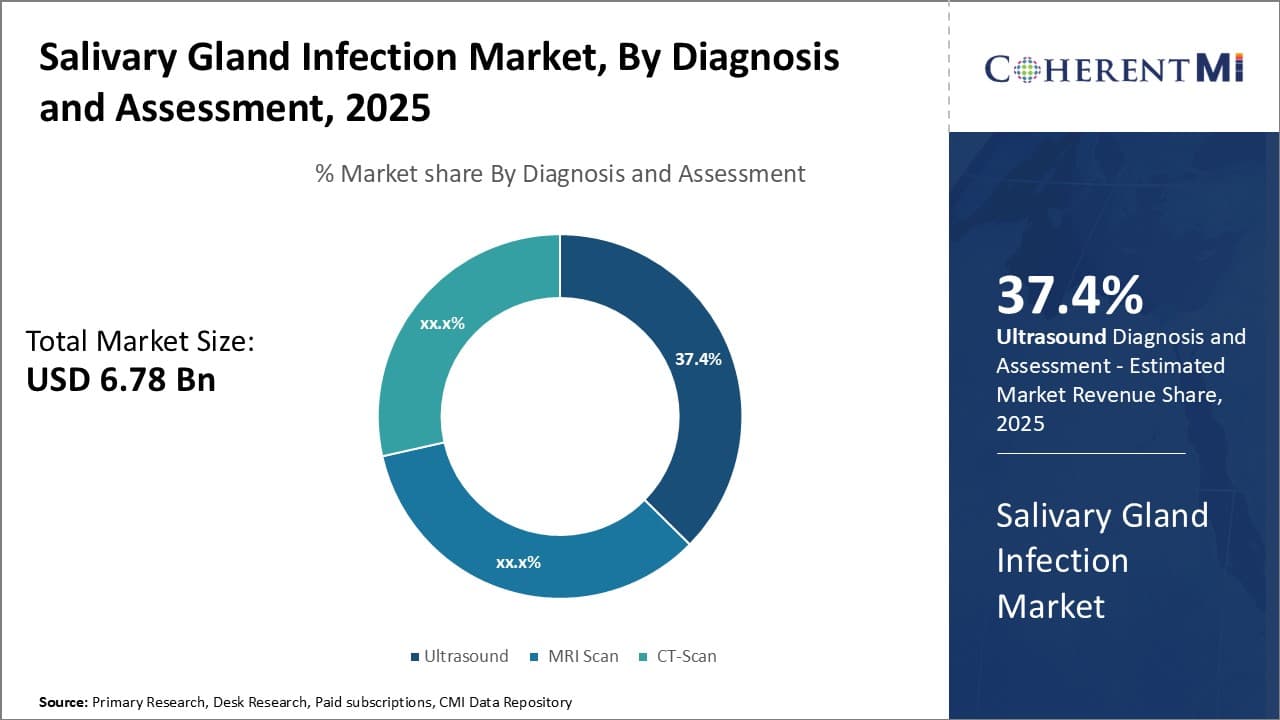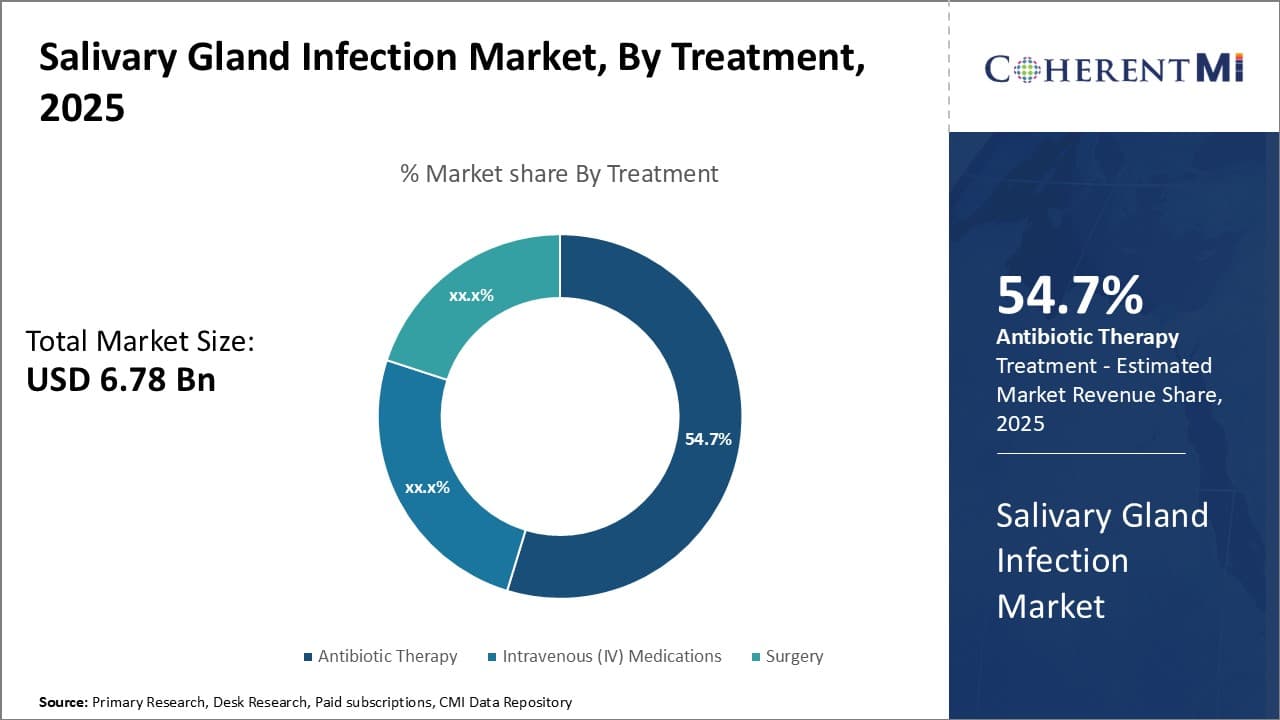

The Salivary Gland Infection Market is valued at USD 6.78 billion in 2025 and is expected to reach USD 12.72 billion by 2032, growing at a compound annual growth rate (CAGR) of 9.4% from 2025 to 2032. The market is driven by the increasing prevalence of salivary gland disorders caused by various factors such as accumulation of debris, presence of bacteria or virus, and tumors.
The market is expected to witness positive growth over the forecast period owing to rising prevalence of infections due to viruses such as mumps virus, increasing consumption of sugary foods and drinks leading to bacterial infections, and growing geriatric population susceptible to chronic disorders affecting salivary glands. However, lack of awareness regarding salivary gland infections especially in developing nations and social stigma associated with chronic infections in some cultures may hamper market growth.
Market Size in USD Bn
CAGR9.4%
| Study Period | 2025-2032 |
| Base Year of Estimation | 2024 |
| CAGR | 9.4% |
| Market Concentration | Medium |
| Major Players | AbbVie Inc., Allergan, AstraZeneca, FUJIFILM Holdings Corporation, GlaxoSmithKline Plc and Among Others |
Market Driver - Rising Awareness of Salivary Gland Infections and Their Management Encourages Patients to Opt for Medical Treatments.
There has been a significant increase in awareness regarding salivary gland infections among people in recent times. Various factors have contributed to the rising awareness such as easy access to health information through online sources, social media influencers spreading health awareness through short videos and blogs, and medical professionals actively educating patients about common infections and their prevention.
People have started recognizing the symptoms of salivary gland infections much earlier compared to a few years back. Even mild symptoms of swelling, tenderness or pain in the salivary gland region are no longer ignored. This has enabled early diagnosis and treatment seeking for salivary gland infections before they aggravate. Public health campaigns in both developing and developed nations promoting oral hygiene and proper dental care have also played a role. With simple messages of maintaining oral cleanliness, flossing regularly and recognizing infections early, these campaigns have informed people about salivary gland health.
The rising awareness has dispelled many myths and misconceptions around salivary gland infections that were prevalent in the past. People are well aware that such infections can affect anyone irrespective of age, are usually caused due to viral or bacterial pathogens, and prompt medical care is necessary. They no longer rely on homemade remedies or ignore mild infections assuming they will resolve on their own. This awareness has led more individuals to consult ENT specialists or dental professionals for diagnosis and treatment guidance in case of concerns regarding their salivary glands.
Access to easy and reliable self-diagnosis tools has also made people cautious about salivary gland health. Various mobile applications and websites provide symptoms checkers that can identify potential salivary gland infections. While self-diagnosis has its limitations, it has empowered people to trace common salivary gland problems to medical attention instead of overlooking the issues. With growing knowledge about salivary gland infections and their management options available, people are no longer hesitant to undergo necessary medical procedures or take prescribed medications and antibiotics course.
Market Driver - Increasing Adoption of Advanced Diagnostic Techniques to Boost Industry Developments.
The diagnostics landscape for salivary gland conditions has transformed significantly in the last decade due to technological advancements. Various non-invasive and accurate diagnostic techniques have been integrated into mainstream clinical practice increasing their availability. This has improved detection and diagnosis of both acute and chronic salivary gland infections.
Imaging techniques such as ultrasound, sialendoscopy, MRI and CT-Scans provide intricate internal views of salivary glands enabling identification of infection signs, blockages and other underlying structural issues with high precision. These help clinicians arrive at an accurate diagnosis instead of merely relying on physical symptoms and tests. This is advantageous as salivary gland conditions may present similar symptoms initially but require customized treatment approaches. Further, chronic or recurring infections which may not show overt physical symptoms can be detected at an early stage using advanced imaging tools.
Lab-based diagnostic techniques have also become more sophisticated. Methods such as microbiological culture and polymerase chain reaction (PCR) provide speedy identification of causal bacterial or viral pathogens. This is valuable for determining most effective treatment like selection of appropriate antibiotic therapy. Biomarker testing and saliva analysis through tools like cytology aids in chronic infection monitoring by detecting infection markers in bodily fluids.
With increasing affordability and insurance coverage for such diagnostic services in both developed and developing nations, more patients are able to undergo comprehensive salivary gland evaluation instead of basic testing previously. This has boosted early detection rates and correct diagnosis of infections. The convenience of non-invasive procedures has further encouraged testing uptake. Faster recovery is being reported owing to accurate customized treatment guided by insights from advanced diagnostic methods. Overall, these have positively influenced patient outcomes and management of salivary gland infection cases.
 To learn more about this report, Download Free Sample Copy
To learn more about this report, Download Free Sample Copy
Market Challenge - Limited Awareness Among Patients and Healthcare Providers About New Treatment Options.
There is a limited awareness among patients as well as healthcare providers about the new treatment options available for salivary gland infections. Majority of patients still rely on over-the-counter medications or generic antibiotics prescribed by their family doctors to treat infections. They remain unaware of newer drug therapies and surgical procedures that can provide better treatment outcomes. This is partly because limited research exists on these new modalities and treatment protocols. Healthcare providers too often lack comprehensive knowledge about latest clinical evidence and innovations. They continue recommending conventional treatment approaches owing to lack of continuing medical education opportunities in this therapeutic area. Pharmaceutical companies and medical device manufacturers have to work towards enhancing awareness through patient engagement programs, symposiums for healthcare professionals, publication of clinical evidence in medical journals etc. Unless awareness levels improve substantially, adoption of new treatment options will remain low impacting growth prospects of innovative therapies.
Market Opportunity- Development of Novel Therapies Targeting Resistant Infections and Chronic Conditions
The development of novel therapies targeting resistant infections as well as chronic salivary gland conditions presents promising opportunities for growth in the market. There is urgent need for new drugs and other treatment methods that can effectively manage antimicrobial resistant infections. The emergence of multi-drug resistant strains of bacteria has limited the use of existing antibiotic armamentarium. Pharmaceutical players can benefit from novel drug design and research aiming to address this unmet need. Similarly, chronic diseases like Sjogren's syndrome which has no cure yet, offers lucrative pipeline opportunities. Industry stakeholders should invest more resources in exploring innovative treatment mechanisms involving gene therapy, regenerative medicines or immunomodulatory approaches for chronic management. Such first-in-class products addressing unmet medical needs are likely to experience high adoption rates. They can capture significant market share and drive growth of the overall salivary gland infection market over the coming years.
Salivary gland infections typically follow a step-wise treatment approach based on the stage and severity of infection. For mild infections, prescribers commonly opt for conservative first-line treatments like warm compresses and over-the-counter pain relievers like ibuprofen (Advil) or acetaminophen (Tylenol) to reduce swelling and discomfort.
If symptoms persist after a few days, antibiotics are prescribed. For acute bacterial infections, amoxicillin (Amoxil) 500mg tablets taken three times daily is a common first-line choice due to its broad-spectrum activity and favorable side effect profile. Alternatively, prescribers may opt for penicillin VK (Veetids/V-Cillin K) tablets or cephalexin (Keflex) capsules.
For infections that show no signs of improvement or spread from the original site, broader-spectrum antibiotics are used. Common second-line choices include clindamycin (Cleocin) capsules, doxycycline (Vibramycin) tablets or azithromycin (Zithromax) tablets/suspension for its extended coverage. If infection is associated with a dental root cause, antibiotics are usually supplemented with drainage or incision and drainage of the affected gland.
Prescribers closely monitor treatment response and may switch to IV antibiotics like ampicillin/sulbactam (Unasyn) or ertapenem (Invanz) if oral options fail. In rare, severe cases where infection is widespread or accompanied by risk factors like diabetes, surgery may be considered to remove the affected gland(s). Overall treatment choice is influenced by infection severity, patient allergies, compliance and insurance coverage.
Salivary gland infections can range from mild to severe depending on the stage and severity of symptoms. Treatment is tailored according to the stage of infection.
For mild infections with minimal pain and swelling, over-the-counter pain relievers like acetaminophen coupled with increased fluid intake may suffice. Antibiotic medication may not be needed.
Moderate infections present with more noticeable swelling and pain. Oral antibiotics are usually prescribed as first-line treatment. Amoxicillin-clavulanate is commonly used due to its effectiveness against common bacterial causes like Staphylococcus and Streptococcus. Severe infections may cause facial swelling and difficulty opening the mouth. This requires prompt medical evaluation and intravenous (IV) antibiotics like ampicillin, piperacillin-tazobactam or clindamycin based on culture/sensitivity reports. IV drugs achieve higher concentrations needed to overcome strong infections.
For infections that do not respond to initial antibiotic therapy, surgical drainage of the abscess may be necessary to remove pus and infected tissues. This helps the antibiotics reach and eliminate all bacteria. Post-operative antibiotics are continued for complete resolution. Recurrent infections may require long-term oral antibiotic prophylaxis or radiotherapy to prevent future flare-ups by reducing number and virulence of causative microbes harbored in the gland tissues over time.
Focus on Innovative Drug Development: Leading pharmaceutical companies like Pfizer, Allergan and AbbVie have invested significantly in R&D to develop novel drug molecules for treating salivary gland infections.
Adopt Combination Therapy Approach: Studies show that a combination of antibiotics along with corticosteroids works better than monotherapy for reducing inflammation and swelling associated with salivary gland infections. Players like Allergan have received approvals for combinations of antibiotics (amoxicillin/clavulanate) with corticosteroids (prednisone). Combination therapies have proven to be more effective with faster recovery, thus driving their adoption rate.
Focus on Emerging Markets: With rising incidence of salivary gland infections in Asia Pacific and Latin America due to high disease prevalence, players like Glenmark Pharmaceuticals focused their sales and distribution efforts in these regions. For example, Glenmark launched their low-cost generic antibiotic cefuroxime axetil in India and Brazil in 2019, capturing over 30% market share within a year due to affordable pricing.
Strategic Collaborations: Strategic partnerships allow leveraging of complementary expertise and resources to accelerate drug development. Novo Nordisk also had an early mover benefit through rights to commercialize novel drugs upon approval.
 To learn more about this report, Download Free Sample Copy
Insights, By Diagnosis and Assessment, Precision Guidance Drives Ultrasound Segment in the Forecast Period.
To learn more about this report, Download Free Sample Copy
Insights, By Diagnosis and Assessment, Precision Guidance Drives Ultrasound Segment in the Forecast Period.
By diagnosis and assessment, ultrasound contributes the highest market share at 37.40% owing to its precise guidance capabilities. Ultrasound provides real-time imaging to help doctors accurately locate salivary gland infections or abnormalities. The non-invasive nature of ultrasound makes it well-suited for initial screenings and follow-up examinations to monitor treatment progress. Advancements in ultrasound technology have improved resolution and added new diagnostic tools. 3D and 4D ultrasound provide highly detailed tomographic views of salivary glands that assist in differential diagnosis. Contrast-enhanced ultrasound with microbubble contrast agents increases diagnostic confidence by enhancing visualization of perfused tissues. elastography techniques have been incorporated which measure tissue stiffness to detect malignancies. Portable and compact ultrasound systems have expanded use to emergency departments and outpatient settings. The ability of ultrasound to safely and precisely locate infections drives its prominent use in diagnosing salivary gland disorders.
 To learn more about this report, Download Free Sample Copy
To learn more about this report, Download Free Sample Copy
Insights, By Treatment, Targeted Therapy To Register Remarkable Growth Throughout the Forecast Period.
By Treatment, antibiotic therapy contributes the highest market share at 54.70% due to the ongoing enhancements in targeted drug delivery. Most salivary gland infections are bacterial in nature and effectively treated with antibiotics. However, high drug concentrations must reach infection sites within the protected glands. Novel drug formulations and delivery methods now ensure antibiotics achieve therapeutic levels locally. Sustained release gels and films coated inside the mouth gradually release drugs over time. Nanoparticle carriers encapsulate antibiotics and transport them across mucosa into infected tissues. Iontophoresis applies a mild electrical current to help transdermally deliver topical antibiotics into affected glands. Some therapies even incorporate real-time ultrasound to aid in targeted deposition of medication. These targeted approaches maximize antibiotic concentrations at infection sites while reducing systemic exposure and side effects. Their ability to precisely deliver therapy is driving antibiotic treatment's leading market position.
Insights, By End User, Centralized Management Boosts Hospitals Segment.
By End User, hospitals contribute the highest share of the market owing to their centralized management of complex cases. While mild salivary gland infections may be initially treated in outpatient settings, more severe or multifaceted cases require specialized hospital resources. Hospitals boast comprehensive diagnostic modalities such as CT, MRI, and specialty ultrasound. They offer full access to invasive surgeries performed in dedicated operating rooms. Multi-disciplinary teams of otolaryngologists, radiologists, oral surgeons and other specialists facilitate complex diagnoses and coordinated treatment planning. In-house pharmacy admixing and rigorous sterile procedures ensure consistent drug preparations. Centralized electronic medical records maximize information sharing between departments. The concentration of specialized skills, technology, and management infrastructure in hospitals provides optimal handling of difficult cases. Their integrated one-stop care model drives hospitals' primary role in treating salivary gland disorders.
The salivary gland infection market is expected to grow significantly due to the rising incidence of conditions like sialadenitis, driven by factors such as aging populations and the increasing prevalence of chronic conditions. With advancements in diagnostic technologies and emerging therapies, there is a growing opportunity for companies to innovate in this space. The unmet needs in this market include the lack of targeted treatments for resistant infections and the need for improved diagnostic precision. As more players enter the market with advanced solutions, the competitive landscape will evolve, potentially lowering costs and increasing accessibility to effective treatments. Enhanced awareness among healthcare providers and patients alike is also expected to drive market growth, making it a key area of focus for future research and development.
The major players operating in the Salivary Gland Infection Market include AbbVie Inc., Allergan, AstraZeneca, FUJIFILM Holdings Corporation, Johnson & Johnson Services Inc, Merck & Co., Pfizer Inc., Siemens Healthcare GmbH and GE Healthcare.
Would you like to explore the option of buying individual sections of this report?
Ghanshyam Shrivastava - With over 20 years of experience in the management consulting and research, Ghanshyam Shrivastava serves as a Principal Consultant, bringing extensive expertise in biologics and biosimilars. His primary expertise lies in areas such as market entry and expansion strategy, competitive intelligence, and strategic transformation across diversified portfolio of various drugs used for different therapeutic category and APIs. He excels at identifying key challenges faced by clients and providing robust solutions to enhance their strategic decision-making capabilities. His comprehensive understanding of the market ensures valuable contributions to research reports and business decisions.
Ghanshyam is a sought-after speaker at industry conferences and contributes to various publications on pharma industry.
Salivary Gland Infection Market is segmented By Diagnosis and Assessment (Ultrasound, MRI Scan, CT-S...
Salivary Gland Infection Market
How Big is the Salivary Gland Infection Market?
The Global Salivary Gland Infection Market is expected to be valued at USD 6.78 billion and reach USD 12.72 billion by 2032.
What will be the CAGR of the Salivary Gland Infection Market?
The CAGR of the Salivary Gland Infection Market is projected to be 9.2% from 2024-2031.
What are the major factors driving the Salivary Gland Infection Market growth?
The rising awareness of salivary gland infections and their management and increasing adoption of advanced diagnostic techniques are the major factor driving the Salivary Gland Infection Market.
What are the key factors hampering the growth of the Salivary Gland Infection Market?
The limited awareness among patients and healthcare providers about new treatment options. and high costs associated with advanced diagnostics and therapies are the major factor hampering the growth of the Salivary Gland Infection Market.
Which is the leading Diagnosis and Assessment in the Salivary Gland Infection Market?
Ultrasound is the leading diagnosis and assessment segment.
Which are the major players operating in the Salivary Gland Infection Market?
AbbVie Inc., Allergan, AstraZeneca, FUJIFILM Holdings Corporation, Johnson & Johnson Services Inc, Merck & Co., Pfizer Inc., Siemens Healthcare GmbH, GE Healthcare are the major players.